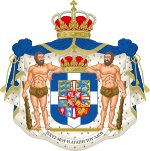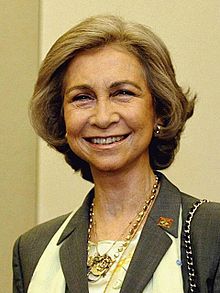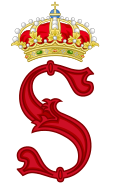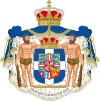Queen Sofía of Spain
| Sofía | |||||
|---|---|---|---|---|---|
 Sofía in 2009 | |||||
| Queen consort of Spain | |||||
| Tenure | 22 November 1975 – 19 June 2014 | ||||
| Enthronement | 27 November 1975 | ||||
| Born | Princess Sophia of Greece and Denmark 2 November 1938 Tatoi Palace, Athens, Greece | ||||
| Spouse | |||||
| Issue | |||||
| |||||
| House | Glücksburg (by birth) Bourbon (by marriage) | ||||
| Father | Paul of Greece | ||||
| Mother | Frederica of Hanover | ||||
| Religion | Catholic Church prev. Greek Orthodox | ||||
| Signature |  | ||||
| Spanish royal family |
|---|
 |
|
Extended royal family
Children of the late Duchess of Badajoz:
The Duchess of Soria and Hernani
|
| Greek royal family |
|---|
 |
|
Doña Sofía (Sophia Margaret Victoria Frederica of Greece and Denmark, Greek: Σοφία; born 2 November 1938) is a member of the Spanish royal family who was Queen of Spain from 1975 to 2014 as the wife of King Juan Carlos I until his abdication. She is the eldest child of King Paul of Greece and his wife, Queen Frederica.
Sofía married then Infante Juan Carlos of Spain in 1962 and became queen of Spain upon her husband's accession in 1975.[1] On 19 June 2014, Juan Carlos abdicated in favour of their son Felipe VI.[2]
Early life
[edit]Princess Sophia of Greece and Denmark was born on 2 November 1938, at Tatoi Palace in Acharnes, Athens, Greece, the eldest child of King Paul and his wife, Queen Frederica. Sofía is a member of the Greek branch of the Schleswig-Holstein-Sonderburg-Glücksburg dynasty. Her brother was the deposed King Constantine II and her sister is Princess Irene.
Her maternal grandmother, Princess Victoria Louise of Prussia, wrote in her 1965 memoir: "I have always had a particular fondness for her, and esteemed her modesty, understanding and goodness coupled with her candid realism touches with a fine sense of humour. There, she is very much like her father. My daughter told me what the little Sophia had once said to her about him: 'You know, Mama, I think we have the nicest Papa in the world.'"[3]
As her family was forced into exile during the Second World War, she spent part of her childhood in Egypt, where she took her early education in El Nasr Girls' College in Alexandria, and South Africa, where her sister Irene was born. They returned to Greece in 1946. She finished her education at the prestigious Schloss Salem boarding school in Southern Germany, and then studied childcare, music and archeology in Athens.[citation needed] She also studied at Fitzwilliam College, Cambridge, a constituent college of the University of Cambridge.[4] She was a reserve member, alongside her brother Constantine, of Greece's gold medal-winning sailing team in the 1960 Summer Olympics.[5]
Marriage and family
[edit]Sofía met her paternal third cousin, the then Infante Juan Carlos of Spain on a cruise in the Greek Islands in 1954; they met again at the wedding of the Duke of Kent, her paternal second cousin, at York Minster in June 1961.[6] Sofía and Juan Carlos married on 14 May 1962, at the Catholic Cathedral of Saint Dionysius in Athens.[6]

Sofía converted from Greek Orthodoxy to Catholicism to become more palatable to Catholic Spain, and thus relinquished her rights to the Greek throne.
Sofía was in Greece on a private visit to her brother, King Constantine II, when the 1967 Greek military coup took place. Except for a brief stay for the funeral of her mother in 1981, Queen Sofía would not visit Greece until 1998.
In 1969, Spanish dictator Francisco Franco named Juan Carlos his successor under the official title "Prince of Spain".[7] Juan Carlos acceded to the throne in 1975, upon the Franco's death.[7] Juan Carlos, after his accession to the Spanish throne, returned with his family to the Zarzuela Palace.
The couple has three children: Elena (born 20 December 1963); Cristina (born 13 June 1965); and Felipe (born 30 January 1968).[8]
Queen consort
[edit]This section of a biography of a living person needs additional citations for verification. (October 2020) |

Besides accompanying her husband on official visits and occasions, Sofía also has solo engagements. In her first public appearance as Queen, Sofía attended a Shabbat service at the Beth Yaacov synagogue in Madrid in June 1976, marking the first time in modern Spanish history that a member of the Spanish royal family had visited a Jewish house of worship.[9]
She is executive president of the Queen Sofía Foundation, which in 1993, sent funds for relief in Bosnia and Herzegovina, and is honorary president of the Royal Board on Education and Care of Handicapped Persons of Spain, as well as the Spanish Foundation for Aid for Drug Addicts. Additionally, she has served as the patroness of the Queen Sofía Spanish Institute since 2003.
Sofía takes special interest in programs against drug addiction, travelling to conferences in both Spain and abroad. The Museo Nacional Centro de Arte Reina Sofía is named after her, as is Reina Sofía Airport in Tenerife.
Sofía is an Honorary Member of the San Fernando Royal Academy of Fine Arts and of the Spanish Royal Academy of History. She has received honorary doctorates from the Universities of Rosario (Bogotá), Valladolid, Cambridge, Oxford, Georgetown, Evora, St. Mary's University (Texas), and New York.

Sofía has been honorary president of the Spanish Unicef Committee since 1971.[10] She has been working closely with Dr. Muhammad Yunus on his Grameen Bank, which offers microcredits to women across the world. Queen Sofía has travelled to Bangladesh, Chile, Colombia, El Salvador and Mexico to support the activities of the organization. Queen Sofía has also been a strong supporter of Somaly Mam's Agir pour les Femmes en Situation Précaire, an NGO combatting child prostitution and slavery in Cambodia. In 1998, Mam was awarded the prestigious Prince of Asturias Award for International Cooperation in the Queen's presence.

As Queen, Sofía never publicly commented on political issues. However, in October 2008, Pilar Urbano's book La Reina muy de cerca ("The Queen up close") sparked strong controversy as it contained alleged statements by the Queen on issues debated in Spanish society. She criticized the military intervention in Afghanistan, where Spanish troops were taking part at the time, defended religious education in schools, and expressed her conviction that gender violence publicity[clarification needed] would encourage new cases to occur. She also rejected abortion and euthanasia as well as same-sex marriage.[11][12] The Royal Household commented that the book "puts in Her Majesty's mouth alleged claims that [...] do not correspond exactly to the opinions expressed by Her Majesty".[13] While the two major parties - Socialists and People's Party - refused to comment,[14] her opinions were subjected to heavy criticism by Republican parties like IU and ERC and LGBT activists.[15][16][17]
In May 2012, Sofía was reportedly refused permission to attend the celebrations for the Diamond Jubilee of Elizabeth II by the Spanish government, citing tensions over fishing rights at Gibraltar.[18]
In July 2012, Sofía visited the Philippines for a fourth time. She inspected several development projects around the former Spanish colony that her country's government is funding via the Agencia Española de Cooperacion Internacional para el Desarollo (AECID). She visited the National Library, National Museum and the Pontifical and Royal University of Santo Tomas, The Catholic University of the Philippines, which had the oldest extant university charter in Asia and housed the world's largest collection of suyat scripts. She also met with Spanish nationals residing in the Philippines, and attended a reception at the Spanish Embassy. She also attended a state dinner in her honour at Malacañan Palace hosted by President Benigno Aquino III,[19][20] and thanked the president for promoting the Spanish language in the Philippine educational system.[21]
Queen mother
[edit]Following her husband's abdication as King in 2014, Sofía has focused on her sponsoring activities,[22] spending her time between La Zarzuela and, in the summer months, the Marivent Palace in Palma de Mallorca. She regularly accompanies her son and his family at events.[23][24]
Honours
[edit]
Queen Sophia was awarded the Order of the Queen of Sheba by Emperor Haile Selassie of Ethiopia in 1973 upon her and her husband King Juan Carlos's visit to the capital Addis Ababa. Sofía was appointed to the Grand Cross of The Royal and Distinguished Order of Charles III on 10 May 1962[25] and to The Royal Order of Queen Maria Luisa on 14 May 1962.[citation needed] The Queen of Spain was appointed to the Collar of the Royal and Distinguished Order of Charles III as dame on 31 October 1983.[26] Since then, Queen Sofía has received different appointments and decorations by more than 40 foreign states. In 2024, Queen Sofía was awarded the collar of the Order of the Golden Fleece.[27]
Arms
[edit]
|
|
Notable published works
[edit]- En Decelia: fragmentos cerámicos de Decelia y miscelánea arqueológica. Athens, (1959–1960). Edited in Spanish in Spain, 2013.[28][29] ISBN 9788494103308
See also
[edit]- Descendants of Christian IX of Denmark - Lists other members of European royalty who share a common ancestor with Queen Sofía of Spain
- Joyas de pasar
References
[edit]- ^ Genealogisches Handbuch des Adels, Fürstliche Häuser XV. "Spanien". C.A. Starke Verlag, 1997, pp. 20, 100–101. (in German) ISBN 978-3-79800-814-4
- ^ "Spain will have two kings and two queens". The Telegraph. 13 June 2014. Archived from the original on 12 January 2022. Retrieved 14 June 2014.
- ^ of Prussia, Princess Victoria Louise (1965). Life as Daughter of the Emperor. p. 259.
- ^ "HM Sofia Queen of Spain". Fitzwilliam College. Retrieved 11 August 2020.
- ^ "Royal Participants at the Olympics". Topend Sports. Retrieved 8 December 2012.
- ^ a b Gay, Danielle (13 May 2019). "Inside Queen Sofía and King Juan Carlos's 1962 wedding". Vogue Australia. Condé Nast. Retrieved 17 September 2020.
- ^ a b Juan Carlos never bore the traditional title of the Spanish heir apparent, Prince of Asturias. Bernecker, Walther (January 1998). "Monarchy and Democracy: The Political Role of King Juan Carlos in the Spanish Transición". Journal of Contemporary History. 33 (1): 65–84. doi:10.1177/003200949803300104. S2CID 157966975.
- ^ "S.M. la Reina Doña Sofía - Biography". Casa Real. Retrieved 25 April 2022.
- ^ "Queen Sophia of Spain Guest at Jewish Sabbath Services". Jewish Telegraphic Agency. 1 June 1976. Retrieved 20 June 2023.
- ^ "Queen Sofía: " "I feel the same as always. Everything is going to carry on as it is"". El Pais. 4 June 2014. Retrieved 9 September 2016.
- ^ Galaz, Mábel (30 October 2008). "No nos queman a nosotros. Son trozos de papel. Ya se apagarán". El País.
- ^ ""No nos queman a nosotros. Son trozos de papel. Ya se apagarán"". El País. 30 October 2008.
- ^ "La Reina tacha de 'inexactas' sus polémicas palabras publicadas en un libro" [The Queen Dismisses Her Controversial Words Published in a Book as 'Inaccurate']. El Mundo (in Spanish). Madrid. 1 November 2008. Retrieved 19 August 2018.
- ^ Garea, Fernando; Foguet, Joan; Asry, Karim; Granda, Elsa (31 October 2008). "PP y PSOE ordenan guardar silencio sobre las declaraciones de la Reina". El País.
- ^ "Queen's First Out-Gay Footman Quits Amid Homophobia Accusations". The Daily Beast. 1 October 2018.
- ^ "Spanish queen breaks silence - and upsets gay groups". The Independent. 30 October 2008.
- ^ "Malestar en el colectivo homosexual por las palabras de la Reina". El País. 30 October 2008.
- ^ Alexander, Harriet (20 May 2012). "Queen Sofia of Spain: Europe's lonely royal consort". The Daily Telegraph. ISSN 0307-1235. Archived from the original on 12 January 2022. Retrieved 24 November 2017.
- ^ [1] Archived 6 July 2012 at the Wayback Machine
- ^ "Albay gives Spanish queen warm welcome". Inquirer Global Nation. 5 July 2012.
- ^ Legaspi, Amita O. (3 July 2012). "PNoy and Spain's Queen Sofía welcome return of Spanish language in PHL schools". GMA News Online. Retrieved 14 June 2018.
- ^ Paniagua, Antonio (2 November 2018). "Una reina que va a más". El Comercio.
- ^ Font, Consuelo (9 July 2016). "Doña Sofía encuentra su refugio en Marivent". El Mundo.
- ^ Simón, Paloma (3 August 2017). "Doña Sofía, la solitaria reina de Palma". Vanity Fair.
- ^ (in Spanish) Decree 1192/1962, 1 June. HRH Princess Sofia Grand Cross of the Order of Charles III. BOE (Spanish Official Gazette), 62/06/01.
- ^ (in Spanish) Royal Decree 2747/1983, 31 October. HM Queen Sofia Collar of the Order of Charles III. BOE (Spanish Official Gazette), 83/11/02.
- ^ (in Spanish) 29 October. HM Queen Sofia awarded the insignia (collar) of the Order of the Golden Fleece. BOE (Spanish Official Gazette), 24/10/29.
- ^ Logintegral Archived 3 November 2013 at the Wayback Machine
- ^ En Decelia: fragmentos cerámicos de Decelia y miscelánea arqueológica.
External links
[edit]- 1938 births
- Converts to Roman Catholicism from Eastern Orthodoxy
- Princesses of Denmark
- Fellows of Exeter College, Oxford
- Fellows of Fitzwilliam College, Cambridge
- Former Greek Orthodox Christians
- Princesses of Greece
- House of Glücksburg (Greece)
- Living people
- Nobility from Athens
- Spanish infantas
- Spanish people of Danish descent
- Spanish people of German descent
- Spanish people of English descent
- Spanish people of Russian descent
- Spanish Roman Catholics
- Spanish royal consorts
- Juan Carlos I
- Members of the Order of the Holy Sepulchre
- Grand Crosses Special Class of the Order of Merit of the Federal Republic of Germany
- Royal Olympic participants
- Autonomous University of Madrid alumni
- Alumni of Schule Schloss Salem
- 20th-century Eastern Orthodox Christians
- 20th-century Roman Catholics
- 21st-century Roman Catholics
- Recipients of the Medal of the Oriental Republic of Uruguay
- Recipients of the Order of Prince Yaroslav the Wise, 1st class
- Daughters of kings
- Spanish queen mothers
- Members of the Order of Jamaica
- Recipients of the Order of Outstanding Merit




